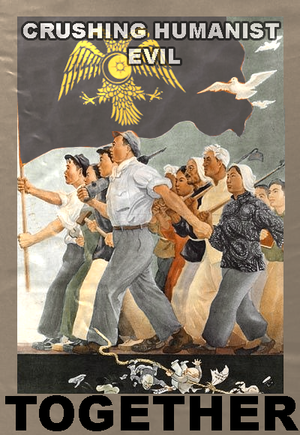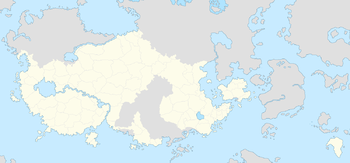Great Apollonian Empire
| Great Apollonian Empire Dai Aporonia Teikoku | |||
| |||
| Motto: Pax Apollonica – Pax Mundi 和平阿波羅尼卡 - 世界和平 | |||
| Anthem: Imperial anthem: Grand Çakari March National flag anthem: All Hail Apollonia! | |||

| |||
| Map versions | 17.4.0 - 17.4.8 | ||
| Capital | Ceremonial capital: Apollonium Summer capital: Agra Winter capital: Daocheng | ||
| Largest city | |||
| Official language(s) | Arboric, Adarani, Audente and Jingdaoese | ||
| Official religion(s) | Craitism and Tianchaodao | ||
| Demonym | Apollonian | ||
| - Adjective | |||
| Government | Constitutional monarchy with parliamentary democracy | ||
| - Emperor | Tobu Emperor | ||
| - Chief Minister | Zhang San | ||
| - Legislature | Apollonian Congress of the Union | ||
| Establishment | 1698 AN - 1704 AN | ||
| Area | 33,760,656 km2 | ||
| Population | 1,050,821,709 (estimation in 1698) | ||
| Currency | Golden Kala (GK or | ||
| Abbreviation | GAE, AE | ||
| Mains electricity | 230/400 V - 50 Hz | ||
| Driving side | left (Çakari community) and right (Jing community) | ||
| Track gauge | Standard railways: 1,435 mm (4 ft 8 1⁄2 in) Mountain railways: 610 mm (2 ft) and 762 mm (2 ft 6 in) Çakari railways: 1,676 mm (5 ft 6 in) | ||
| Calendar | Norton calendar | ||
| Time zone(s) | CMT-3, CMT, CMT+1, CMT+1:30 and CMT+4 | ||
| National website | |||
| National forum | none | ||
| National animal | Hoopoe (Upupa epops) | ||
| National food | |||
| National drink | |||
| National tree | Apollonian Cypress (Cupressus sempervirens) | ||
Great Apollonian Empire (Arboric: إمبراطورية أبولونيان الكبرى; Adarani: ग्रैंड अपोलोनियन साम्राज्य; Audente: Apolloniana Magni Imperii; Jingdaoese: 大阿波羅尼亞帝國 or Dai Aporonia Teikoku) was a sovereign state located on the continent of Apollonia. The nation emerged after the Post-Chidao Troubles with the adoption of the Articles of the Union in 1698 AN. The ceremonial name of the nation was Empire of the Rising Sun and Crescent Moon. The name was also shortened to Apollonian Empire, Apollonia or Great Apollonia, which may be confusing with the name of the continent Apollonia.
The Great Apollonian Empire was the largest country on Micras in area, as well as being the most populous. The nation shares its borders with the following countries (counterclockwise): Democratic Environmental Society of Senya, Natopian Arboria, Confederate States of Floria, Natopian Saint Andre, International Mandate for the Settlements in Apollonia. New Alexandrian Ijubicastagrad, Emirate of Arbor in Barikalus and Hurmu.
The successes of the largest empire of Micras were shortlived when an ongoing economical crisis led to the eruption of violence and strikes on the streets of the Jingdaoese Community. The Second Kildarian Revolution in 1704 AN ended in the collapse of the nation. The eastern part of the Empire continued as the Çakar Empire.
Etymology
History
Post-Chidao Troubles and Conference of Apollo
- See also: Post-Chidao Troubles

The creation of the Great Apollonian Empire was forged during the Post-Chidao Troubles. With the transcendence of the Chidao Emperor to the Heaven in 1695 AN, the Great Jing were in disarray. With ethnic minorities, political adversaries vowing for power in its local assemblies, and a successor - the Xinshi Emperor - having been left out of decision making by her father, a power struggle between its several factions led to a full-blown partition of its Empire between warlords.
Immediately after the disaster, Imperial Magistrate Lin Zexu (responsible for order within the capital) ordered the house arrest of most of the members of the Grand Secretariat, including the Diwang Jin San. Under suspicion of having plotted against the Chidao Emperor, investigations were held (and eventually found the ascension to be the sole viable option). The lockdown and collapse of leadership, led to Tegong Marshal Li Suyi's order to concentrate all Tegong officers near the capital, in Qaoshan Province. The momentum created by the sudden disappearance of the secret police due to their occupation elsewhere was gladly abused by rebellious factions. In Xianbei, workers took to the street, pushed by Tsukono Wei's teachings and the Nokarodo Faction.
In the north, a group of officers pressured the decorated Field Marshall Tzao Yao to march south to "crush progressive and anti-Jing influences and liberate the Heavenly Light". A disorganised move of almost a million soldiers southwards echoed through the streets of Bangou Province, which was suddenly left with a handful of under supplied garrison soldiers.
The chaotic southwards march came to an abrupt halt in southern Qianjin Province, when it was threatened by the Tegong, which in the meanwhile had established a warring state. By then, revolutionary Kildari had taken possession of Yuanbeicheng and several important towns and cities in the Dalmacija region. The Armed Forces, now recognised under the Field Marshall as 'another one of the warlords', was seen as the Western Gunbatsu and was stuck between two fronts. Despite owning the largest amount of troops, its lack in supplies hindered any potential attacks.

By 1696 AN, the Great Jing were roughly divided between a pro-independence Dalmacijan Thanedom, a leftist Xianbei state, a Tegong State (with a terrible track record for human rights), the Imperial Government, a Western and Eastern Gunbatsu Clique (with local commanders fighting over its limited supplies and troops). Fearing escalation, the local assemblies of Jinkeai and Xianxia Province formed the League of United Jingdaoese Provinces, which remained loyal to the Heavenly Light, but refused to wage any fights until the situation had stabilised. The Kantai-Ha Clique, the Jingdaoese Navy, remained neutral and gathered resources to keep its fleet afloat in an attempt to thwart any direct intervention from foreigners.
In the east, the tribal warlord Taizong of Seishi established the Seishi Clique and hoped to establish a large Apollonian empire under his rule. This eventually triggered a reaction from Çakaristan, which invaded with permission of the Xinshi Emperor and eradicated the Seishi in 1698 AN.
Slowly but steadily, the Heavenly Court regained control over the situation. With most factions - especially a tired Army - recognising imperial authority once more, a conference was held. The Xinshi Emperor, unwilling to meddle in politics, showed support for ZHang San's proposal to unite both Çakaristan and the Great Jing in a federation of states. The several warlords, having depended on the cooperation of local assemblies (which were in most cases the sole form of authorities still functioning), grudgingly agreed to hold a referendum.
With most warlords falling back in line and State assemblies and governors becoming the foremost representation of Apollonians, the civil war increasingly became refocussed on the troubles on the Dalmacijan theatre. The Heavenly Court had, in absence of representatives of the Bangou and Qianjin Province, negotiated its ascendency as (one, united) State. With increasing aid from foreign sources and a so-called crusade to 'liberate Kildare', resources were brought into place to counter-attack between 1699 and 1700 AN.
Tobu Era (1698 - present)
Geography
Time zones
When the Great Apollonian Empire was formed, the time zones of the unionizing states were adopted. The time zones were implemented based on the Coordinated Micras Time, an initiative of the Royal Julius Civilis University in Batavia. Overview of the time zones in the Great Apollonian Empire:
- CMT-3: All regions of the Jing community, except for West Nuristan, regardless of geographic location
- CMT-1: Nuristan
- CMT 0: Bulqan, Haritdesh, Leylpur, Pathaardesh
- CMT+1: Korhalistan, Poorajangal, Sylfystan
- CMT+1:30: Jabal al-Mada'
- CMT+4: Sri Pashana
Government
Imperial Court

The first, and up till now only, Emperor was the Tobu Emperor, also known as Akbar of the House of Çakar. As head of state, the Emperor wields a huge influence over its subjects. Despite the limits in which the Emperor can interfere domestically, he is both an important figurehead and commander-in-chief of the Armed Forces. He is also the head of all national Great Apollonian orders, decorations, medals, and awards. In Federal Territories, the Court can directly interfere in the appointment of its governor and its legislative processes.
Making use of the divide between political factions, the Court is seen as one of the important unifying factors of the Empire and - depending from State to State - revered to a certain degree.
The Emperor and his family resides in the royal capital, Agra D.A., but as political affairs demand his attention elsewhere, he's known to be travelling rather much between Apollonium, D.A. and the royal capital.
Chief Minister and Cabinet
Apollonian Congress of the Union
Administrative subdivisions

The two empires which made up Great Apollonia were heavily centralised realms in origin. The Great Jing only saw a move from power and responsibility to provincial assemblies during the 1690's, as a immediate response to shift any possible blame of incompetence away from the Heavenly Court in the aftermath of the 1690 Jingdaoese recession. During the Post-Chidao Troubles, those legislations were often the only agencies still functioning in a decent capacity, and therefore they won influence and prestige.
The Çakar, while initially conquerors of the former Krasnocorian territories, had been proponents of centralised power in the hands of its sultan in the wake of the Sylvanian National Awakening (1687 -1688 AN). Its subjugation of large swaps of territories, however, made governing those difficult - or even impossible - without relying on local elites.
The tendency of growing local power and autonomy remained when the Conference of Apollo was held. Depending on the local situation, former provinces were established as new States or Territories within the Empire.
Traditionally, the regions conquered by the Tobu Emperor before his ascension of the Twho-Headed Eagle Throne, hold a larger number of Federal Territories which are more strongly tied to the Imperial Court. The Emperor appoints its governor and the Territory holds no representation in the Seanad. However, a majority of the Empire is made up of States. These have both representation within the Seanad as Union Assembly, which makes up the Apollonian Congress of the Union. Most States refer to themselves as Principality, Province,... due to its past and culture.
Two cities of political and strategical importance, Agra and certain outer districts from the city of Xiacheng formed Apollonium D.A., which became Districts of Apollonia. These DA's have one representative in the Seanad, in contrast with Federal Territories. For a while, Daocheng was considered as third DA, but the idea was shot down by a commission in 1699 AN, which was worried about conflicting influences between the Heavenly Light and federal authorities. Daocheng was eventually accepted as part of one of the Empire's States, Dazijin.

